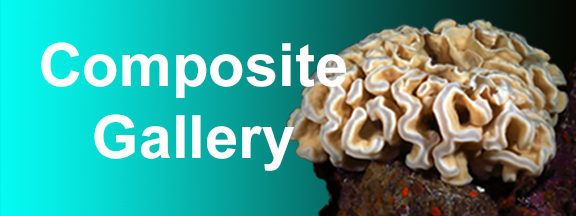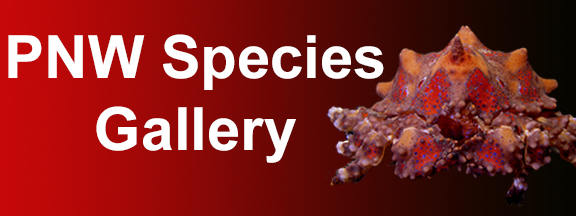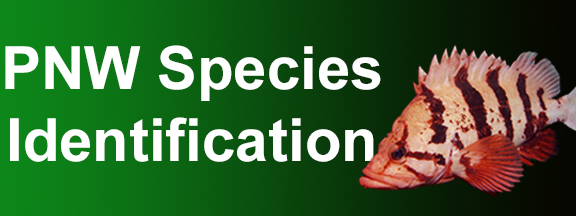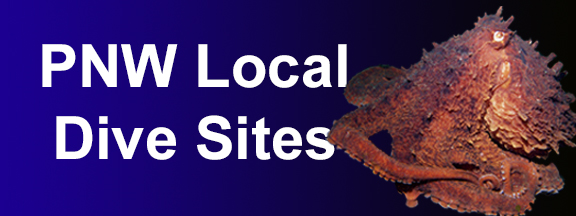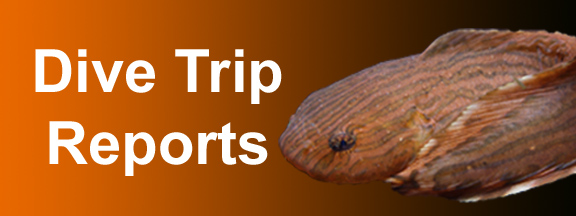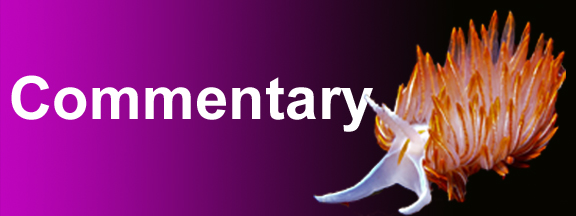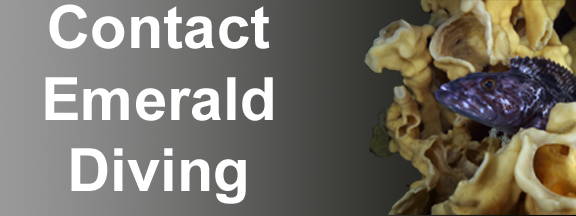

The enlargement viewer only works properly once ALL images on this page are loaded.
Blacktip Poacher
Xeneretmus latifrons
Typical Size: 6-8” length
ID: Single spine on nose with black outline along dorsal. Hard, armored body.
Comments: I rarely note the armored blacktip poacher. When I do note this species, it is usually during night dives indicating that it may be nocturnal. Like the other poaches, the blacktip remains completely motionless when approached.
Xeneretmus latifrons
Typical Size: 6-8” length
ID: Single spine on nose with black outline along dorsal. Hard, armored body.
Comments: I rarely note the armored blacktip poacher. When I do note this species, it is usually during night dives indicating that it may be nocturnal. Like the other poaches, the blacktip remains completely motionless when approached.
Northern Spearnose Poacher
Agonopsis vulsa
Typical Size: 6-8” length
ID: Two blunt spines on the end of the snout. Hard armored body.
Comments: I note the northern spearnose more often than any other species of poacher. With its unusual looking snout, the this poacher is easily distinguished from other species. I can sometimes gently slip my hand under this poacher and pick it up as its defense mechanism is to remain motionless.
Agonopsis vulsa
Typical Size: 6-8” length
ID: Two blunt spines on the end of the snout. Hard armored body.
Comments: I note the northern spearnose more often than any other species of poacher. With its unusual looking snout, the this poacher is easily distinguished from other species. I can sometimes gently slip my hand under this poacher and pick it up as its defense mechanism is to remain motionless.
Sturgeon Poacher
Agonus acipenserinus
Typical Size: 6-10” length
ID: Long snout and high forehead. Pronounced whiskers. Hard plates along body.
Comments: The largest of the poachers in our water, I only occasionally run into sturgeon poacher. Like other poachers, I most often note this species on night dives, indicating that it might be nocturnal - or maybe I just pay better attention at night. With its armored body, the sturgeon poacher makes like a rock and remains motionless when approached.
Agonus acipenserinus
Typical Size: 6-10” length
ID: Long snout and high forehead. Pronounced whiskers. Hard plates along body.
Comments: The largest of the poachers in our water, I only occasionally run into sturgeon poacher. Like other poachers, I most often note this species on night dives, indicating that it might be nocturnal - or maybe I just pay better attention at night. With its armored body, the sturgeon poacher makes like a rock and remains motionless when approached.
Tubenose Poacher
Pallasina barbata
Typical Size: 4-6” length
ID: Long slender armored body with protruding lower jaw two dorsal fins.
Comments: The tubenose poacher prefers the shallow confines of eel-grass beds and can often be seen resting on eel-grass blades as pictured here. I often note this fish when shore diving Sekiu Jetty Rocks, which is where this photo was taken.
Pallasina barbata
Typical Size: 4-6” length
ID: Long slender armored body with protruding lower jaw two dorsal fins.
Comments: The tubenose poacher prefers the shallow confines of eel-grass beds and can often be seen resting on eel-grass blades as pictured here. I often note this fish when shore diving Sekiu Jetty Rocks, which is where this photo was taken.
Pygmy Poacher
Odontopyxis trispinosa
Typical Size: 2-4" length
ID: Indentation at the beginning of the plate behind the head and single cirrus at the corner of the mouth.
Comments: This small poacher only has one whisker at the corner of each side of its mouth. Note the leach affixed to the top of this poacher's head. I find these poachers in abundance in summer months at Three Tree Point.
Odontopyxis trispinosa
Typical Size: 2-4" length
ID: Indentation at the beginning of the plate behind the head and single cirrus at the corner of the mouth.
Comments: This small poacher only has one whisker at the corner of each side of its mouth. Note the leach affixed to the top of this poacher's head. I find these poachers in abundance in summer months at Three Tree Point.


